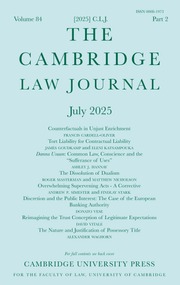No CrossRef data available.
Article contents
The Merits of Trial by Jury
Some Aspects of English Jury Trial and Continental Modes of Trial
Published online by Cambridge University Press: 16 January 2009
Extract
During the House of Commons debate on crime on 8 August 1966, Mr. David Ensor expressed some doubt as to the efficacy of the jury system. He compared it with systems in a number of European countries where three judges, or one judge and two or more assessors (lay justices), decide all questions of law and fact. He thought that this Continental system was working perfectly well.
- Type
- Articles
- Information
- Copyright
- Copyright © Cambridge Law Journal and Contributors 1972
References
1 H.C., Vol. 733, col. 1072.
2 The Proof of Guilt (3rd ed., London 1963), p. 299.Google Scholar
3 The Jury (London 1968), p. 9.Google Scholar
4 On the contrary most lawyers in England think that the abolition of the system is most unlikely: Devlin, P., Trial by Jury, 3rd ed. (London 1966)Google Scholar; Archer, P., The Queen's Courts 2nd ed. (London 1968) p. 175.Google Scholar Doubts about the merits of the lay assessor system are expressed in a study of the English jury system: Knittel, E., Das englische Schwurgericht (Bonn 1968), p. 99Google Scholaret seq, and 122 et seq.
5 Devlin, P., Trial by Jury, 3rd ed. (London 1966), p. 90Google Scholar; Williams, op. cit, at p. 260; for further arguments against the principle of the “omnipotence du jury” see Schwinge, E., Der Kampf um die Schwurgerichte (Breslau 1926), p. 110Google Scholaret seq.
6 H.L., Vol. 191, col. 85.
7 Devlin, op. cit., at p. 161.
8 In still less important cases two “Schoeffen” sit together with a single judge (s. 28 et seq. of the German Gerichtsverfassungsgesetz).
9 Romberg, H. P., Die Richter ihrer Majestaet (Stuttgart 1965), p. 122Google Scholaret seq.
10 Cornish, op. cit., p. 206 et seq.
11 Gruenhut, M., Das englische Strafrecht (Mezger-Schoenke-Jescheck, Das auslaendische Strafrecht der Gegenwart (Berlin 1959), Vol. 3, p. 191).Google Scholar
12 Indictments Act 1915, s. 5.
13 Cf. his dissenting opinion in the “Wemhoff Case,” (1968)Google Scholar European Court of Human Rights, unofficial German translation at p. 43.
14 Stephen J. F., A History of the Criminal Law of England (London 1883), Vol. 1, at p. 566.
15 Williams, op. cit., at p. 282.
16 Devlin, op. cit., at p. 122.
17 Jacta, M., Beruehmte Strafprozesse, England 11 (Muenchen 1965) at p. 146Google Scholaret seq.
18 Blackstone W., Commentaries on the Laws of England (Oxford 1768), Vol. 4 at p. 349 et seq.
19 Jackson, R. M., The Machinery of Justice in England (6th ed., Cambridge 1972), p. 391.Google Scholar See also: Cornish, op. cit., p. 126 et seq.
20 Ibid., 391, note 2.
21 Williams, op. cit., at p. 6 et seq.
22 The Lawyer (1964), p. 44.Google Scholar
23 H.L. Vol. 185, col. 137 et seq.; H.C., Vol. 536, col. 2075.
24 Devlin, op. cit. at p. 164.
25 Jescheck, H. H., Le Jury face au droit pénal moderne—Considerations de droit comparé, Traveaux de la troisième Journée d'études juridiques Jean Dabin (Bruxelles 1967), p. 168Google Scholaret seq.
26 Ibid. at p. 150 et seq.
27 Kalven, H. Jr., and Zeisel, H., The American Jury (Boston and Toronto 1966), p. 13.Google Scholar
28 Ibid. at p. 418.
29 Ibid. at p. 420.
30 Ibid. at p. 149 et seq.
31 Ibid. at p. 318 et seq.
32 Op. cit. at p. 252 et seq.


